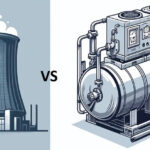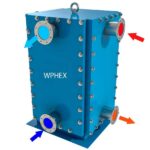Rupture disks or Bursting disks! this article will draw some general overview on these devices and touch on their types as well as sizing methods.
What are Rupture disks?
Rupture disks also known as bursting disks are safety devices mainly used to protect vessels, piping and other pressure containing components from excessive pressure (over pressure) and/or vacuum. Rupture disks don’t close like valves do, they instead as the name dictate rupture or burst. They don’t have moving parts and faster acting than pressure relief valves as they react quickly to pressure spikes in the system they are installed in.

When do we use Rupture disks?
Rupture disks can be used as stand-alone or in combination with relief valves. This mainly depends on the system scenario; we can use a rupture disk as stand-alone if:
a. We need a fast-acting device,
For example, we have a potential of a runaway reaction in a vessel and a fast-acting device is needed to prevent catastrophic failure. A relief valve can still be installed for protection from other relieving scenarios.
Another example, for heat exchangers tube rupture scenarios where they maybe liquid flashing occurs and there is a need to detect overpressure spikes.
b. High viscosity liquids,
Systems with high viscous liquids should use rupture disk device as a preferable option because fluid flow through a relief valve may not be fast enough.
c. The system contains material that can plug the relief valve during relief operation. Such as solids or liquid that freezes when rapid relief occurs.
d. If system content loss isn’t an issue, as rupture disks are non-closing devices, any lost content will content will continue until some form of intervention take place, providing that safety is maintained at all cost, we don’t want to release toxic hazardous content that may cause harm.
e. Cost saving
A Rupture disk capital cost is less than relief valves as they require low maintenance and normally replaced when they rupture.
When do we combine Rupture disks with Relief valves?
It’s a common practice to use a rupture disk in combination with a relief valve, with the rupture disk installed upstream or downstream of the relief valve. The installation mainly depends on the process requirement; for example;
- Saving money on regular maintenance, say we have a system with corrosive environment, we can specify a rupture disk with a corrosion resistant material that can be installed downstream or upstream of the relief valve to act as a barrier between the material and the relief valve.
- If the system contains solids that may plug the relief valve overtime, as the relief valve is continuously exposed to the system a rupture disk may be installed upstream of the relief valve.
- If the system contains toxic material and there is a concern that the relief valve may leak so we install the rupture disk upstream of the relief valve. This way we ensure a seal of the system in question.

Types of Rupture disks
There are mainly three types that this article will not do in details to describe them;
a. Forward acting, tension loaded
b. Reverse acting, compression loaded
c. Graphite, shear loaded
Some Common Terminology
Design Pressure: This is mainly the Equipment or vessel maximum operating pressure increased by 10% or 25 psig whichever higher
Bursting Pressure: also called rupture pressure or set pressure, this is mainly the pressure at which the rupture disk will open
Sizing Methods
Standard Methods are detailed in American Petroleum Institute API RP520 Part 1, API RP520 Part 2 and American Society of Mechanical Engineers ASME Section VIII, Division 1.
There are three basic methodologies for sizing rupture disk devices
- Coefficient of discharge (Kd) method
- Resistance to flow (Kr) method
- Combination capacity method
Coefficient of discharge (Kd) method
Uses a fixed coefficient of discharged (Kd) of 0.62 which is applied to the flow rate. The method is used for systems where the following MUST APPLY!
- The rupture disk must be installed within 8 pipe diameters of the vessel nozzle.
- The length of the discharge piping must not exceed 5 pipe diameters.
- The rupture disk must discharge directly to atmosphere.
- The inlet and outlet piping are at least the same nominal pipe size as the rapture disk.

The method calculate the flow area which is also referred to as the Minimum Net Flow Area, this is the minimum cross sectional area required to meet the needed flow for the rupture disk, basically it’s not the final size for the rupture disk. When purchasing the rupture disk from a manufacturer; the Minimum Net Flow Area must be known, When a rupture disk device is selected it should have a NetFlow Area equal or greater than the Minimum Net Flow Area calculated.
Calculation can then be repeated with the actual Net Flow Area.
The method has a disadvantage as it’s restricts the choice to 8 & 5 rules above, this can be difficult to realise in the initial phase of a project.
The resistance to flow method described below is valid for all cases and can be a good choice for initial phases of the project undertaken.
Resistance to flow (Kr) method
This method can be used in all cases also if the coefficient of discharge method doesn’t apply. This method analyses the flow capacity of the relief piping and by taking into account frictional losses of the relief piping and all piping components.
The Kr value represents the velocity head loss due to the rupture disk device, this is including the full system losses calculations to determine the relief system capacity.
Kr value is determined experimentally by the rupture disk manufacturer, the value is mainly a measure of the flow resistance through the rupture disk, this also takes into account the rupture disk characteristics. Manufacturers would normally define a Kr for a rupture disks size range.
API RP521 part 2 recommends using K of 1.5
ASME Section VII div.1 recommends using Kr of 2.4
It’s always a better practice to know which manufacturer the rupture disk device will be purchased from beforehand as this would provide a better estimate value for Kr. If no information is provided then go for the larger Kr value as a guess then adjust the calculations when the actual Kr value is known.
To use this method all the information below should be known:
- Relieving pressure (upstream pressure) and downstream pressure
- Fluid properties and flow rate that needed for the rupture disk (relieving flow rate)
- Pipe size used
Combination capacity method
This method is used when a rupture disk device is installed in combination with a pressure relief valve. In this case the rupture disk is totally dependant on the relieve valve sizing. The presence of a rupture disk acts to de-rate the relief valve capacity. The derating factor is defined as the Combination Capacity Factor (CFF). This factor is derived from data obtained for the certified capacity testing of the combination of the relief valve and the rupture disk as well as a stand alone capacity certification testing of the relief valve. This testing is done on the manufacturer end.
The final outcome is calculating the ratio of the relief valve and rupture disk combination capacity to the stand-alone relief valve capacity.
CFF = Combination capacity flow / Stand-alone relief valve capacity flow
The value is always less than or equal to 1
If this value is not known, ASME requires that this value does not exceed 0.9
References and further reading
- API Recommended Practice 520, Sizing, Selection, and Installation of Pressure-Relieving Devices in Refineries, Part I—Sizing and Selection, 7th edition, January 2000
- API Recommended Practice 520, Sizing, Selection, and Installation of Pressure-Relieving Devices in Refineries, Part II—Installation, 5th edition, August 2003
- API Recommended Practice 521, Guide for Pressure-Relieving and – Depressuring Systems, 4th edition, March 1997
- American Society of Mechanical Engineers, Boiler and Pressure Vessel Code Section VIII, Division 1, 1998 Edition
- Fike Technical Bulletin TB8102, Rupture Disc Sizing, February, 2000
Useful Software Tools
Process engineering calculator
Desktop edition – Mobile edition










